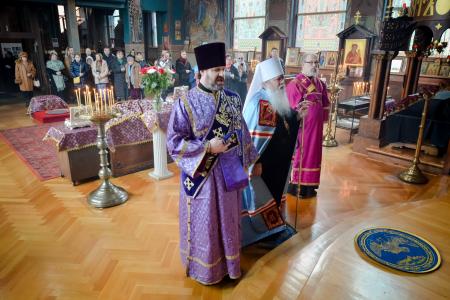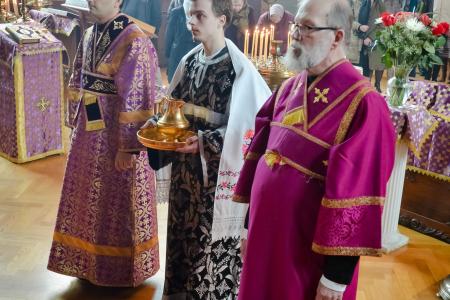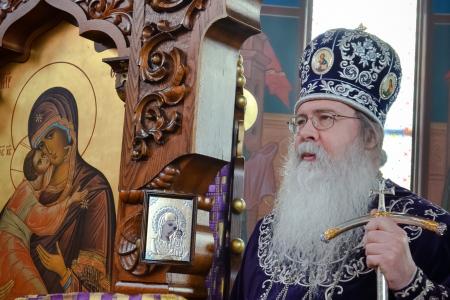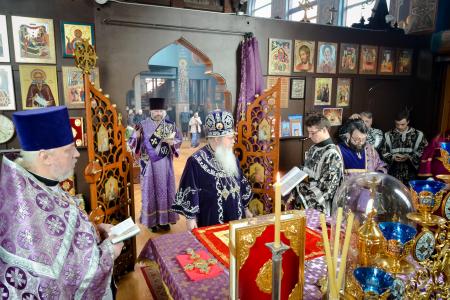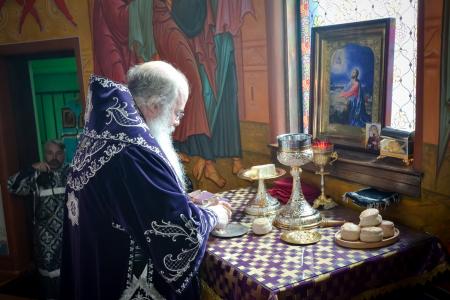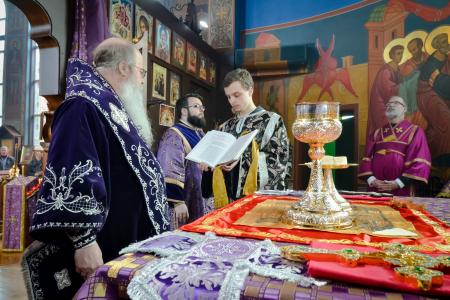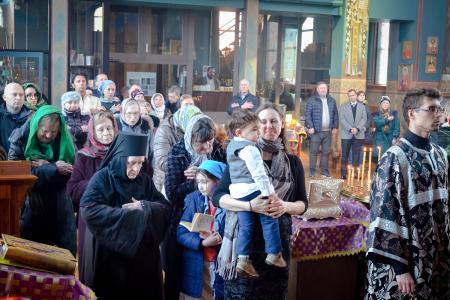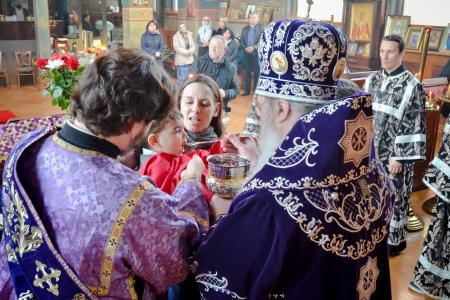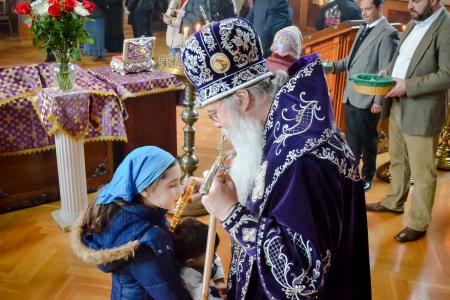On March 4, 2018, the Second Sunday of Great Lent dedicated to the memory of Saint Greogry of Palamas, His Beaitude, Metropolitan Tikhon visited Holy Trinity Church, Brooklyn, NY at the invitation of His Eminence, Archbishop Michael.
Welcoming Metropolitan Tikhon as he entered the church was Priest Alexander Revyuk, Rector.
Founded in 1909 by immigrants from Belarus, Holy Trinity Church has served countless faithful during its 100-plus year history. The parish’s current church was constructed in 1935 in traditional Russian style. In the late 1950s, the interior was enhanced with murals by famed iconographer Pimen M. Sofronoff.
Today, Holy Trinity Church ministers to Brooklyn’s large and ever-growing eastern and central European immigrant population.
Homily of His Beatitude, Metropolitan Tikhon
Holy Trinity Church, Brooklyn, NY
Sunday of Saint Gregory Palamas
March 4, 2018
In the Name of the Father, and of the Son, and of the Holy Spirit.
My dear brothers and sisters in Christ,
In the Gospel reading we heard today, our Lord, God and Savior Jesus Christ refers to Himself as a Door. He says: “I am the door, by me if any man enter in, he shall be saved and shall go in and out and find pasture” [John 10:9]. The Scriptural image of the Lord as a door is found often in our divine services and in our tradition. What exactly does the Lord mean when He refers to Himself as the Door through which we enter to be saved? What does it mean to “be saved,” and how do we enter in through the Door?
We often speak about salvation in an abstract way, as something that is either far away in the distant future or as something that can be achieved right away by a simple intellectual statement. At one time or another, we have all either been approached by someone, or we have seen someone on television, asking the question: “Are you saved?” We have also thought about salvation as an event that occurs at the time of our death, something that we really don’t have to worry about now.
In the understanding of Orthodox Christianity, salvation is neither of those extremes but is rather a more profound union of those two extremes: salvation is at once a great and eternal gift which the Lord will bestow upon us, and it is a gift which, by the grace of God, we can partake of even today in our normal, everyday lives. A door usually leads to somewhere and so, after referring to Himself as the Door, the Lord continues by saying: “I am come that they might have life, and that they might have it more abundantly” [John 10:10]. When we speak about salvation, we are speaking about this life, a life which is not simply biological existence, but is “more abundant,” that is overflowing. And this means that even in our frail human condition, even during our earthly struggle, we can be filled with this overflowing life. And this happens within the Holy Church, in our divine services and in our participation in the divine mysteries.
A concrete example of the way in which Christ opens up the door to this gift of abundant life is given in today’s Gospel account of the healing of the man sick with palsy. This man, who was so ill that he could not even bring himself to the Lord, is an image of each of us—each of us who is sick and broken in one way or another. Today’s paralytic had to rely on his friends to carry him up on top of the house in which Christ was preaching and to lower him through an opening in the roof. And we know that it is not as easy to find healing for ourselves. We cannot simply wish for healing or wish for salvation. We must receive help from others, from our brothers and sisters in Christ.
The paralytic provides an image of great faith, and his friends provide an image of the community of the Church. These particular friends were willing to bear the ridicule and take the risk of doing such an unusual and perhaps dangerous action for the sake of their friend who was in great need of help. When we pray for our loved ones or our friends who are sick, we are acting like this man’s friends, carrying them to the Lord for healing. In other words, we are opening the door for them to Christ. This is why we commemorate so many names in the Divine Liturgy. When we sacrifice our time and our energy for our family, our friends and our neighbors, we are giving expression to the communal effort required for salvation.
The Gospel account tells us that when Jesus saw their faith, He said to the man sick with palsy: “Son, thy sins be forgiven thee.” Why does the Lord say to the man that his sins are forgiven when all the man was seeking was the healing of his body? Because the healing of our body is closely connected to the healing of our soul, just as sin is closely connected to physical illness. We must be careful, however, not to draw too close of a connection between illness and sin, as if sin were the cause of our illness or as if illness was a sign of our sinfulness. This can certainly be the case sometimes, but it is more accurate to say that both sinfulness and illness are manifestations of our need for healing and for salvation. We are all ill and broken in one way or another. Some of us suffer from physical ailments, others from mental illness, and still others from spiritual sicknesses. But all of us are broken in some way and all of us need to find healing in Christ. What is most crucial for us is not to dwell on our brokenness, but to seek out healing.
And this healing is what we mean by salvation; this is what it means to enter through the Door and be saved. The Lord reveals this clearly when He offers the paralytic healing of both his soul and body. When the scribes object that it is only God Who can forgive sins, the Lord confirms that He is God by both forgiving his sins and healing him. He said to the skeptics: “That ye may know that the son of man hath power to forgive sins, He said to the sick of the palsy: ‘I say unto thee, Arise and take up thy bed, and go thy way into thine house.’” Here the Lord is confirming His words by His actions, and showing that indeed His healing of the man’s physical illness is inseparable from His forgiving the man’s sins. He heals the whole person.
In this way, the Lord is showing that He is the Good Shepherd Who gives His life for His sheep and is the model of all the true shepherds who would come after Him—shepherds like Saint Gregory Palamas, whose memory we celebrate on this, the second Sunday of Great Lent. Saint Gregory also faced similar opposition to the truth as the Lord Himself endured from the scribes in today’s Gospel. This is because Saint Gregory also sought to preserve the true teaching that is it possible for man to behold the glory of God and, through his participation in that glory, to attain healing. Saint Gregory fought against those who claimed that, when God revealed His glory, He was doing it by means of created things. He corrected these wrong-thinking people by preserving the truth that, while we cannot know the essence of God, which is unknowable and beyond the comprehension of our limited human minds, we can nevertheless participate, by grace, in God’s divine energies. This participation in God’s divine energies is what we mean by salvation, for salvation is our communion with God. The essence and purpose of our Christian life is union with our Lord and Savior Jesus Christ. This is the teaching of the Lord Himself, and this is the teaching of the Apostles and of all the Holy Fathers, such as Saint Gregory.
May we all receive encouragement from today’s Gospel reading, and not only hear the words of life which the Lord preaches, but also put those words into practice in our own lives, so that we too might, by grace, receive the eternal life which is God’s by nature. And may we continue to ask for the help and intercessions of those saints, such as Saint Gregory Palamas, who by their own lives of virtue and holiness confirm to us that the miracles of healing which our Lord worked many years ago can take place in our own times and in our own lives. And by their true and Orthodox teachings, which they impart to us both through their lives and through their writings, they reveal to us that it is possible for all of us to receive a foretaste of eternal salvation in this life—the eternal salvation that is the gift of the All Holy Trinity, the Father, the Son and the Holy Spirit, one in essence and undivided, now and ever and unto the ages of ages. Amen.
Photo Credit: Subdeacon Roman Ostash

